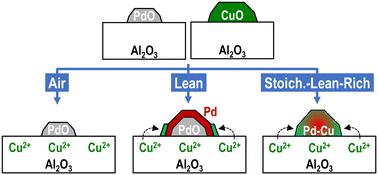当前位置:
X-MOL 学术
›
Catal. Sci. Technol.
›
论文详情
Our official English website, www.x-mol.net, welcomes your feedback! (Note: you will need to create a separate account there.)
Thermal deactivation of Pd/Al2O3–Cu/Al2O3-combined three-way catalysts via Cu migration and alloying
Catalysis Science & Technology ( IF 4.4 ) Pub Date : 2024-08-19 , DOI: 10.1039/d4cy00854e Zannatul Mumtarin Moushumy 1 , Marina Takeuchi 1 , Masayuki Tsushida 2 , Keisuke Awaya 3 , Hiroshi Yoshida 4 , Junya Ohyama 3, 5 , Masato Machida 3, 5
Catalysis Science & Technology ( IF 4.4 ) Pub Date : 2024-08-19 , DOI: 10.1039/d4cy00854e Zannatul Mumtarin Moushumy 1 , Marina Takeuchi 1 , Masayuki Tsushida 2 , Keisuke Awaya 3 , Hiroshi Yoshida 4 , Junya Ohyama 3, 5 , Masato Machida 3, 5
Affiliation

|
A Cu oxide catalyst supported on γ-Al2O3 (Cu/A) is a promising candidate for substituting platinum group metals in automotive three-way catalysts (TWCs). Cu/A can be used by mixing with a Pd catalyst supported on γ-Al2O3 (Pd/A). In this study, the effect of thermal aging on the nanostructure and TWC performance of the physically mixed powder catalyst (Pd/A + Cu/A) was investigated under different environments, that is, simulated exhaust gas mixtures dynamically fluctuating among stoichiometric, fuel-lean, and fuel-rich (SLR) compositions, compared with static fuel-lean (L) and air at 600–900 °C. The observed thermal deactivation was strongly dependent on aging atmosphere, and it increased in the sequence air < L < SLR with increasing aging temperature. Characterization studies showed Pd–Cu alloying in most deactivated SLR-aged catalysts in contrast to air-aged catalysts, which consisted of Pd oxide dispersed on the Cu2+-incorporated γ-Al2O3 phase. During SLR aging, some of the incorporated Cu2+ species migrated to the surface, reduced to the metallic state, and immediately reacted with Pd metal to form a Pd–Cu random alloy with face-centered cubic structure. This phenomenon severely deteriorated the NO reduction activity because the Pd surface enriched with Cu lacks NO dissociation ability. Therefore, the observed deactivation was more evident for NO reduction than C3H6 oxidation but was nearly negligible for CO oxidation because Cu2+-incorporated γ-Al2O3 exhibited high CO oxidation activity superior to that of Pd catalysts. Deactivation via Pd–Cu alloying was inevitable even in air- and L-aged catalysts when repeating the TWC light-off experiment under a stoichiometric gas mixture.
中文翻译:

通过 Cu 迁移和合金化实现 Pd/Al2O3–Cu/Al2O3 组合三效催化剂的热失活
负载在 γ-Al 2 O 3 (Cu/A) 上的氧化铜催化剂是替代汽车三效催化剂 (TWC) 中铂族金属的有希望的候选者。 Cu/A可以通过与担载在γ-Al 2 O 3 (Pd/A)上的Pd催化剂混合来使用。本研究研究了不同环境下热老化对物理混合粉末催化剂(Pd/A+Cu/A)纳米结构和TWC性能的影响,即模拟废气混合物在化学计量、燃料-配比之间动态波动。贫油和富油 (SLR) 组合物与 600–900 °C 的静态贫油 (L) 和空气相比。观察到的热失活很大程度上取决于老化气氛,并且随着老化温度的增加,热失活在空气%3C L%3C SLR序列中增加。表征研究表明,与空气老化催化剂相比,大多数失活的 SLR 老化催化剂中存在 Pd-Cu 合金化,空气老化催化剂由分散在 Cu 2+掺入的 γ-Al 2 O 3相上的 Pd 氧化物组成。在SLR老化过程中,一些掺入的Cu 2+物质迁移到表面,还原为金属态,并立即与Pd金属反应形成具有面心立方结构的Pd-Cu随机合金。这种现象严重恶化了 NO 还原活性,因为富含 Cu 的 Pd 表面缺乏 NO 解离能力。 因此,观察到的NO还原失活比C 3 H 6氧化更明显,但对于CO氧化几乎可以忽略不计,因为Cu 2+掺入的γ-Al 2 O 3表现出优于Pd催化剂的高CO氧化活性。在化学计量气体混合物下重复 TWC 起燃实验时,即使在空气老化和 L 老化催化剂中,Pd-Cu 合金化的失活也是不可避免的。
更新日期:2024-08-19
中文翻译:

通过 Cu 迁移和合金化实现 Pd/Al2O3–Cu/Al2O3 组合三效催化剂的热失活
负载在 γ-Al 2 O 3 (Cu/A) 上的氧化铜催化剂是替代汽车三效催化剂 (TWC) 中铂族金属的有希望的候选者。 Cu/A可以通过与担载在γ-Al 2 O 3 (Pd/A)上的Pd催化剂混合来使用。本研究研究了不同环境下热老化对物理混合粉末催化剂(Pd/A+Cu/A)纳米结构和TWC性能的影响,即模拟废气混合物在化学计量、燃料-配比之间动态波动。贫油和富油 (SLR) 组合物与 600–900 °C 的静态贫油 (L) 和空气相比。观察到的热失活很大程度上取决于老化气氛,并且随着老化温度的增加,热失活在空气%3C L%3C SLR序列中增加。表征研究表明,与空气老化催化剂相比,大多数失活的 SLR 老化催化剂中存在 Pd-Cu 合金化,空气老化催化剂由分散在 Cu 2+掺入的 γ-Al 2 O 3相上的 Pd 氧化物组成。在SLR老化过程中,一些掺入的Cu 2+物质迁移到表面,还原为金属态,并立即与Pd金属反应形成具有面心立方结构的Pd-Cu随机合金。这种现象严重恶化了 NO 还原活性,因为富含 Cu 的 Pd 表面缺乏 NO 解离能力。 因此,观察到的NO还原失活比C 3 H 6氧化更明显,但对于CO氧化几乎可以忽略不计,因为Cu 2+掺入的γ-Al 2 O 3表现出优于Pd催化剂的高CO氧化活性。在化学计量气体混合物下重复 TWC 起燃实验时,即使在空气老化和 L 老化催化剂中,Pd-Cu 合金化的失活也是不可避免的。





































 京公网安备 11010802027423号
京公网安备 11010802027423号